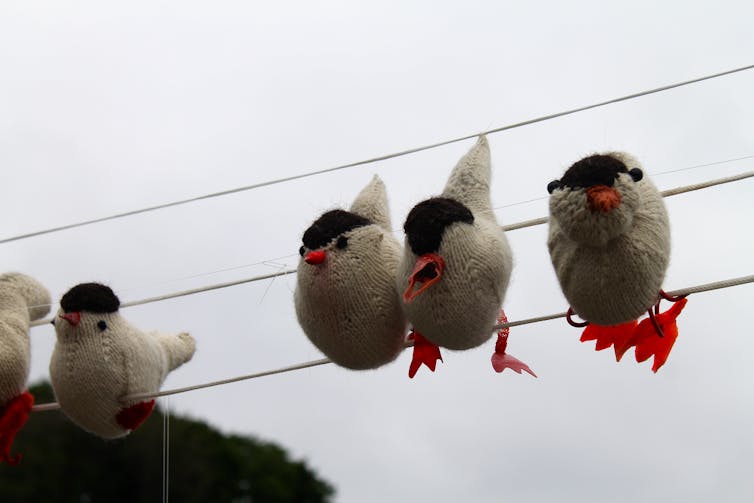Something needs to be done about climate change, that much at least 196 countries agree on. But as the next weeks, months and years see politicians, scientists and industry thrashing out what the “first comprehensive global treaty to combat climate change” means in practice, we collectively face some tough questions. The wrangling has only just begun.
Alongside an unprecedented number of heads of state, COP21 also witnessed an unprecedented number of artists gathering in Paris for the “conference of creative parties”, ArtCOP21. In doing so, a global network of cultural engagements with climate change was created.
The scientific community increasingly recognises the value of interdisciplinary action in the face of problems such as climate change, and the perspectives of social sciences are increasingly valued. But the prospects of arts and humanities are less often appreciated. As well as the poster-art activism of Brandalism, and the numerous film screenings, art installations, performance works and participatory art activities that took place during the talks, a growing number of arts organisations including Cape Farewell, Julie’s Bicycle and Tipping Point advocate passionately for the value of creative responses to climate change.
So what can art do?
Woolly birds
Knitting is perhaps an unlikely vehicle for connecting people with local climate change. Yet Deidre Nelson’s project Bird Yarns (2011), supported by Cape Farewell, did just that. Nelson worked with communities on Mull and the surrounding Scottish Islands to develop a simple pattern that enables amateur and experienced knitters alike to produce woolly Arctic terns, a species once commonly seen in the islands.

These felted avian forms were eventually displayed, firstly at Tobermory Harbour and eventually at galleries around Scotland. Accompanied by a scientific soundtrack, knitting became a way to tell the story of the tern’s fate under climate change. The birds are increasingly failing to mate and their offspring are starving as shifting ocean circulation patterns break up breeding grounds and threaten food stocks.
Such local stories challenge the dominant Western mascots of climate change: distant geographies of marooned polar bears and melting glaciers calving great chunks of ice into the sea. They challenge the notion of climate change as an abstract science of tipping points, thresholds and boundaries. Artists can bring climate change “back home”, enabling us to sense its effects on our own local places and environments.
Whispering forests
What do the trees sound like? This is a question that Swiss artist Christina della Giustina asked the environmental scientists she worked with during her residency at WSL, the Swiss Federal Laboratory for research into Forest, Landscape and Snow. At WSL scientists use century-long data records concerning atmospheric composition and vegetation health to develop contemporary predictions of environmental change.
Accompanying them into the field and working alongside them in the lab, della Giustina explored how these scientists “know” the trees they study. Her ongoing project You Are Variations (2007- ) encourages alternative ways of knowing, sometimes by setting different registers of visualization alongside one another – from hand drawing to high-resolution images. She also uses participatory art to encourage scientists to engage with the local communities living around the trees they study, and develops sound art that incorporates the sonification of live data streams with orchestral compositions.

Such multi-dimensional engagement is worlds away from the techno-scientific interpretations of climate change and thus so many of the practices and discourses of climate security that circulate at events such as COP21. But an increasingly large proportion of art about climate change is, like della Giustina’s work, made by artists working in collaboration with scientists. Organisations such as the Swiss Artists-in-Labs place artists in scientific laboratories, giving them access to equipment, techniques and data. Often the result is art that has not only evolved in response to these scientific tools, but that is also critical of the terms upon which scientific knowledge is made.
Amateur science
Amateur scientific practice can have a part to play, too, as in the Thames Estuary project Wrecked: On the Intertidal Zone (2015). The project saw the development of a series of experiments combining myriad ways of knowing the estuary, setting the practices of local bird watchers, fishermen and mud walkers among scientific studies and information gleaned through political and corporate wranglings.
Scientists, it is often assumed, are the climate experts. They are the ones with the information about causes and effects, the strategies for intervention and mitigation. But amateur knowledge is vital, too. Historically, for example, community records and artistic representations have had a key role in environmental reconstructions. More recently, artists have combined participatory practices with citizen science to remake the terms of the production of science. Unseating the singular image of the climate expert they open out a broader sense of who understands and can intervene with our changing environments.

The global nature of the agreement reached at COP21 might mark history, but these promises, inadequate as they are, still need to be translated into action. While climate change remains the preserve of scientific experts, politicians and activists, and while the popular imaginary is dominated by stranded polar bears, confused penguins and cracking ice-bergs, action is likely to be limited.
Localising climate change, developing collaborative engagements with climate scientists, and enabling grass-roots amateur experimental practices and local knowledge might not seem like much. But all this might empower us to remake climate science from below. If the COP21 proposals, widely regarded as inadequate by the scientific community, are to come close to tackling this global crisis, some creative action is needed.

